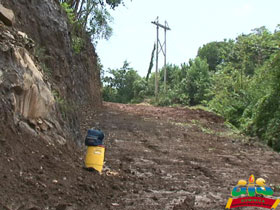Petite Soufriere – Rosalie Trail
Petite Soufrière
is a small village on the east coast of Dominica. The name is misleading as
it suggests that there would be some sulphur springs in the village or in its
vicinity. That is not, however, the case.
The road from
Castle Bruce to south ends at Petite Soufrière. The 2.08 kilometers between it
and Rosalie is the last part of Dominica's
east coast that is still lacking a motorable road. A beautiful morning hike
starts ideally from Roche Marqué cape to get to Rosalie. Walking to the top of the ridge overlooking Petite
Soufriere the hiker gets a grand view down towards the east coast, the rugged
bays and steep headlands plunging into the Atlantic Ocean.
Petite Soufriere was one
of those areas, which because of the topography, escaped being part of the
mainstream plantation structure. It developed as one of the peasant
proprietor communities producing mainly coffee, cocoa, cassava and other root crops. It was
settled mainly by petit blanc smallholders from Martinique;
ancestors of the present day Durand, Coipel and Toussaint families who now
occupy the area and who had mixed with their small numbers of African slaves
and neighbourhood Caribs to form the Creole mix. For the mean time this stretch of the original
coastal walking road is one of the last surviving examples of what the walking
trails around the coast of Dominica
used to be like.
Rosalie estate is situated on the east coast on the banks
of the Rosalie River. It was one of the largest estates
on the island, totaling 2,081 acres, but since the 1960s much of it has been
sub-divided and sold off. It produced sugar, cocoa, limes, bananas and coconuts
at various times in its history. The ruins of an aqueduct and sugar works are
still standing and the site of the old estate house can be seen on the hill
above the works near to the modern estate house. The first British owners
included Governor William Stuart and in the 19th 20th century the Johnson family. A
maroon attack on the estate buildings under the maroon chief Balla took place
here in December 1785. After
emancipation a village developed around the estate yard and there was, for a
time, a police station, school and church, but when new owners, Messrs. Leach
and Tabor, took over in the 1950s the land was reclaimed and the villagers had
to dismantle their houses and disperse to the settlements at Grand Fond and
Riviere Cyrique. The church was abandoned and fell into ruin, but in the 1990s
it was restored and is now the site of the FMI Retreat Centre.
Recommencement of phase two of the Rosalie to
Petite Soufriere road public road construction resumed on March 28, 2011 and is
on-going. The construction of the
twenty-five million EC dollar new road is a grant funded project and covers
4.16 kilometers of road work. Photos of
the magnificent views along the trail are below.








Text Credit
Bethel SDA Church
Dr. Lennox
Honeychurch
GIS,
Government of Dominica







